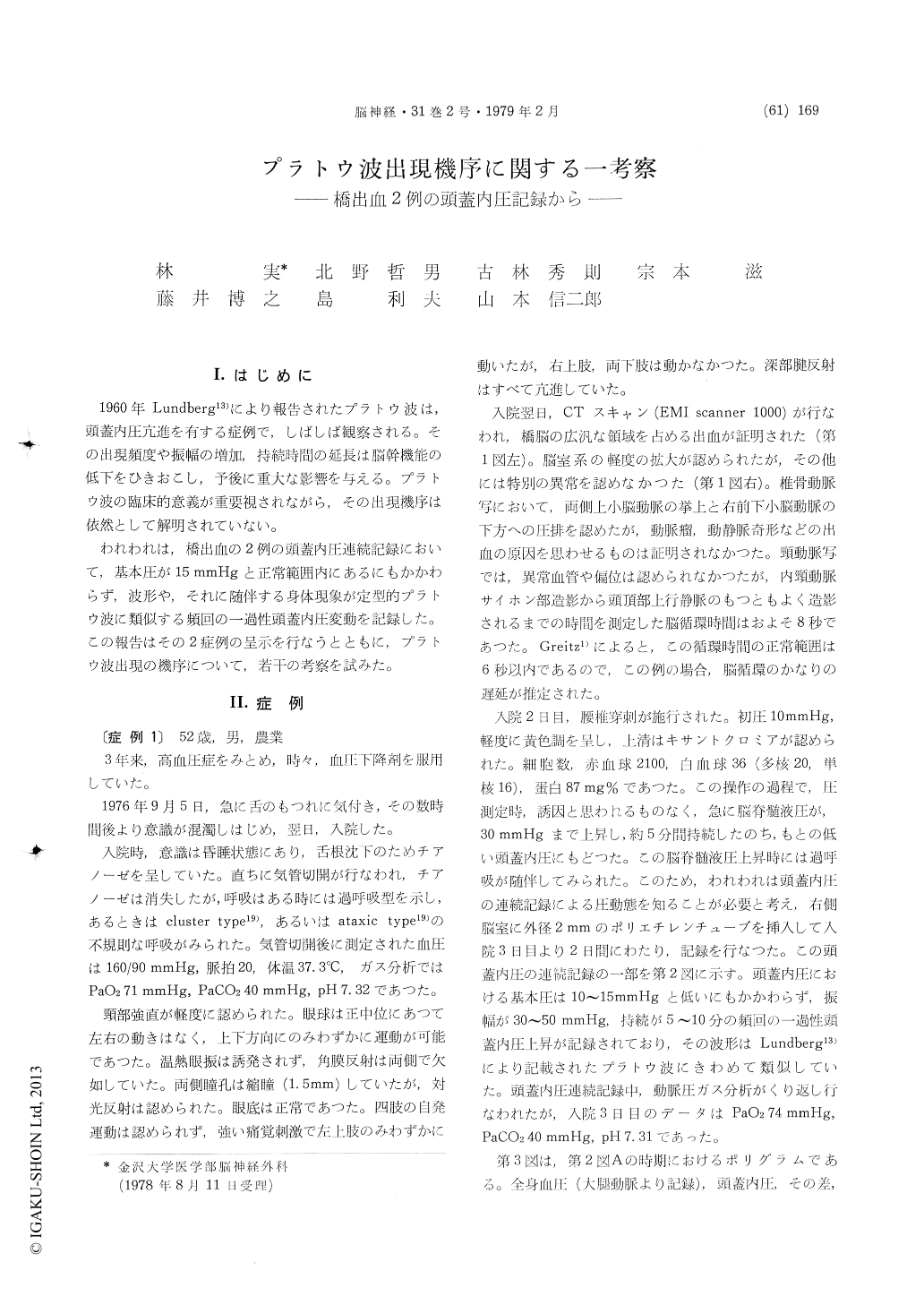Japanese
English
- 有料閲覧
- Abstract 文献概要
- 1ページ目 Look Inside
I.はじめに
1960年Lundberg13)により報告されたプラトウ波は,頭蓋内圧亢進を有する症例で,しばしば観察される。その出現頻度や振幅の増加,持続時間の延長は脳幹機能の低下をひきおこし,予後に重大な影響を与える。プラトウ波の臨床的意義が重要視されながら,その出現機序は依然として解明されていない。
われわれは,橋出血の2例の頭蓋内圧連続記録において,基本圧が15mmHgと正常範囲内にあるにもかかわらず,波形や,それに随伴する身体現象が定型的プラトウ波に類似する頻回の一過性頭蓋内圧変動を記録した。この報告はその2症例の呈示を行なうとともに,プラトウ波出現の機序について,若干の考察を試みた。
In patients with intracranial hypertension, plateau waves as described by Lundberg (1960) are sometimes observed. Lundberg states that increasing duration and height of the plateau waves, and decreasing intervals between them are always ominous signs predicting a state of continuously high intracranial pressure and lasting signs of brain stem dysfunction. In spite of the clinical importance of the plateau waves being emphasized, the precise mechanism of production of the plateau waves is still obscure.
We experienced two cases of pontine hemorrhage who showed frequent acute transient rises of intra-cranial pressure in continuous intracranial pressure recording. These transient intracranial pressure rises developed from a low basic level of intra-cranial pressure. The height of each wave usually ranged only between 20-50 mmHg, i. e., the waves seen in these patients were smaller than those seen with increased intracranial pressure from brain tumor. Nevertheless, they had characteristics to those of the plateau waves. Furthermore, the extracranial phenomena during the waves in these patients, such as no systemic blood pressure change, bradycardia and hyperventilation resembled those of the typical plateau waves. These show that the acute transient rises of intracranial pressure in the present cases were very similar to the typical plateau waves as described by Lundberg. CT scan was made in one of the cases and revealed that the ventricular system was very small during the waves as compared with the interval of the waves. This finding also agreed with the previously known observations that the cerebral blood flow decreases at the same time as the cerebral blood volume increases during the typical plateau waves.
Plateau wave phenomenon is considered to be related to the dilatation and later constriction of cerebral resistance vessels involved in the auto-regulation of cerebral blood flow. However, it is still not known whether this vasodilatory reaction is of metabolic or neurogenic or myogenic origin. From our experiences in the presented cases, wewould suggest the following possibility for develop-ment of plateau waves. Impaired neurogenic cerebrovascular control and dysautoregulation (due to the pontine lesion in our cases) produce a marked reduction in cerebral circulation. This has a close relation to the cerebral metabolic activity, pre-sumably following hypoxic metabolites of the brain, and induces dilatation of cerebral vessels responsible for producing plateau waves. This explanation is in accordance with the evidence that regulations of the cerebral blood flow may mainly be mediatedby the central neurogenic mechanisms as well as cerebral metabolism. According to this assumption, moderately or severely elevated intracranial pressure alone is not always a prerequisite for plateau waves to occur. This possibility may explain that plateau or plateau-like waves are sometimes observed in normal pressure hydrocephalus patients whose cerebral blood flow is strikingly reduced.

Copyright © 1979, Igaku-Shoin Ltd. All rights reserved.


